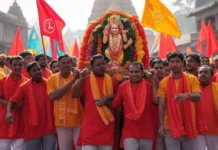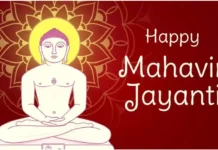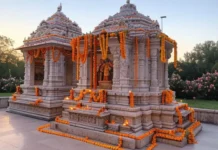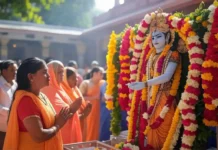Sankat Chaturthi is an important day in the Hindu calendar, especially for devotees of Lord Ganesha, the remover of obstacles. Celebrated with fervor across India, this day holds a special significance in helping devotees seek blessings for overcoming life’s challenges.
The word “Sankat” means difficulties or obstacles, and “Chaturthi” refers to the fourth day of the lunar fortnight, which is the day dedicated to Lord Ganesha. Observing Sankat Chaturthi is believed to bring relief from troubles, bring good fortune, and invoke the divine blessings of Lord Ganesha.
The occasion is marked by fasting, prayers, and rituals, where worshipers come together to offer their devotion to Lord Ganesha.
While Sankat Chaturthi occurs every month, its observance is most significant on the fourth day of the waxing moon, falling once a month, especially for those who experience frequent challenges in their personal lives.
People prepare offerings, chant mantras, and reflect on Lord Ganesha’s teachings to foster peace and prosperity.
Key Details
| Date & Day | Varies (occurs once every month on the fourth day of the waxing moon) |
|---|---|
| Theme | N/A (Theme varies based on the year and region) |
| Organizing Body | Local Temples, Devotees, Community Groups |
| Type of Observance | Regional (India) |
| Best Hashtags | #SankatChaturthi, #LordGanesha, #RemoveObstacles, #ChaturthiCelebration, #GaneshBlessings |
History and Origin
Sankat Chaturthi has its origins in ancient Hindu traditions, specifically related to Lord Ganesha, who is considered the divine force that helps remove obstacles in both spiritual and material life.
According to Hindu mythology, Lord Ganesha was born on the fourth day (Chaturthi) of the waxing moon, and his birthday is celebrated as Ganesh Chaturthi. Sankat Chaturthi, however, is not a festival but a monthly observance where devotees pray for the removal of problems, particularly financial and personal challenges.
The tradition of observing Sankat Chaturthi likely evolved from early Vedic rituals when Ganesha was worshipped as a deity of wisdom and success.
Over time, this day became a way for people to connect with Lord Ganesha and seek his blessings for overcoming life’s struggles. The practice gained prominence through local temples and communities, which organized prayers and rituals for Lord Ganesha’s intervention in difficult situations.
Importance and Objectives
The primary aim of Sankat Chaturthi is to seek Lord Ganesha’s intervention in removing obstacles that may impede progress in one’s life.
This day provides a dedicated time for reflection, devotion, and prayer, allowing worshipers to express gratitude while asking for blessings in areas such as career, family, health, and wealth.
It serves as a reminder that difficulties are part of life, but with faith and devotion, they can be overcome.
Many people also observe fasting on Sankat Chaturthi to demonstrate their commitment to Lord Ganesha, and during this time, they strive to live a life that reflects the values of wisdom, perseverance, and humility.
How It Is Celebrated
The celebrations of Sankat Chaturthi are largely focused on worshiping Lord Ganesha through prayers, offerings, and fasting. Here’s how people typically observe this auspicious day:
- Fasting and Abstinence: Many devotees fast on Sankat Chaturthi, refraining from consuming food or drinking water for the day as an offering to Lord Ganesha. It is believed that fasting helps purify the body and mind, creating a closer connection with the divine.
- Ganesha Puja (Prayer Ritual): Devotees gather in temples or at home to perform a Ganesha Puja. The puja involves chanting sacred mantras like “Om Gan Ganapataye Namah,” offering flowers, incense sticks, and sweets like modaks (a favorite of Lord Ganesha).
- Recitation of Vedic Hymns and Mantras: A key part of Sankat Chaturthi celebrations is the recitation of Ganesha Stotras (hymns) and chanting of mantras. Devotees believe that these chants invoke Ganesha’s blessings and help ward off obstacles.
- Community Gatherings: In many regions, local communities come together for prayers and celebrations. These gatherings often include communal prayers, the distribution of prasad (blessed food), and devotional music.
- Prayers for Specific Needs: People pray to Lord Ganesha to resolve personal or professional difficulties. This day is often seen as a chance to renew one’s faith and seek divine intervention for solving various challenges in life.
Interesting Facts
- Lord Ganesha’s Favorite Food: The modak, a sweet dumpling filled with coconut and jaggery, is considered Lord Ganesha’s favorite food. It is commonly offered during Sankat Chaturthi.
- Monthly Celebration: Unlike Ganesh Chaturthi (which is celebrated annually), Sankat Chaturthi is observed every month on the fourth day of the waxing moon.
- Spiritual Significance: The day is seen as a reminder to overcome life’s obstacles with faith, discipline, and perseverance, inspired by Lord Ganesha’s wisdom and teachings.
- Global Observance: While primarily celebrated in India, Sankat Chaturthi has also spread to countries with large Hindu populations, including Nepal, Mauritius, and Fiji.
Quotes or Messages
- “May Lord Ganesha bless you with wisdom to overcome obstacles in your path.”
- “On Sankat Chaturthi, may every challenge in your life be turned into an opportunity for growth and success.”
- “With Lord Ganesha’s blessings, there are no obstacles too big to overcome.”
Conclusion
Sankat Chaturthi is a deeply meaningful observance that helps us connect with Lord Ganesha’s divine power to overcome the obstacles in our lives. Whether you are facing personal struggles or seeking peace and prosperity, the day provides an opportunity to renew faith and invite positive changes.
Share your thoughts or experiences with Sankat Chaturthi in the comments below. For more content on religious observances and traditions, explore related articles on our website. Don’t forget to join our WhatsApp Channel for updates and community discussions!




























